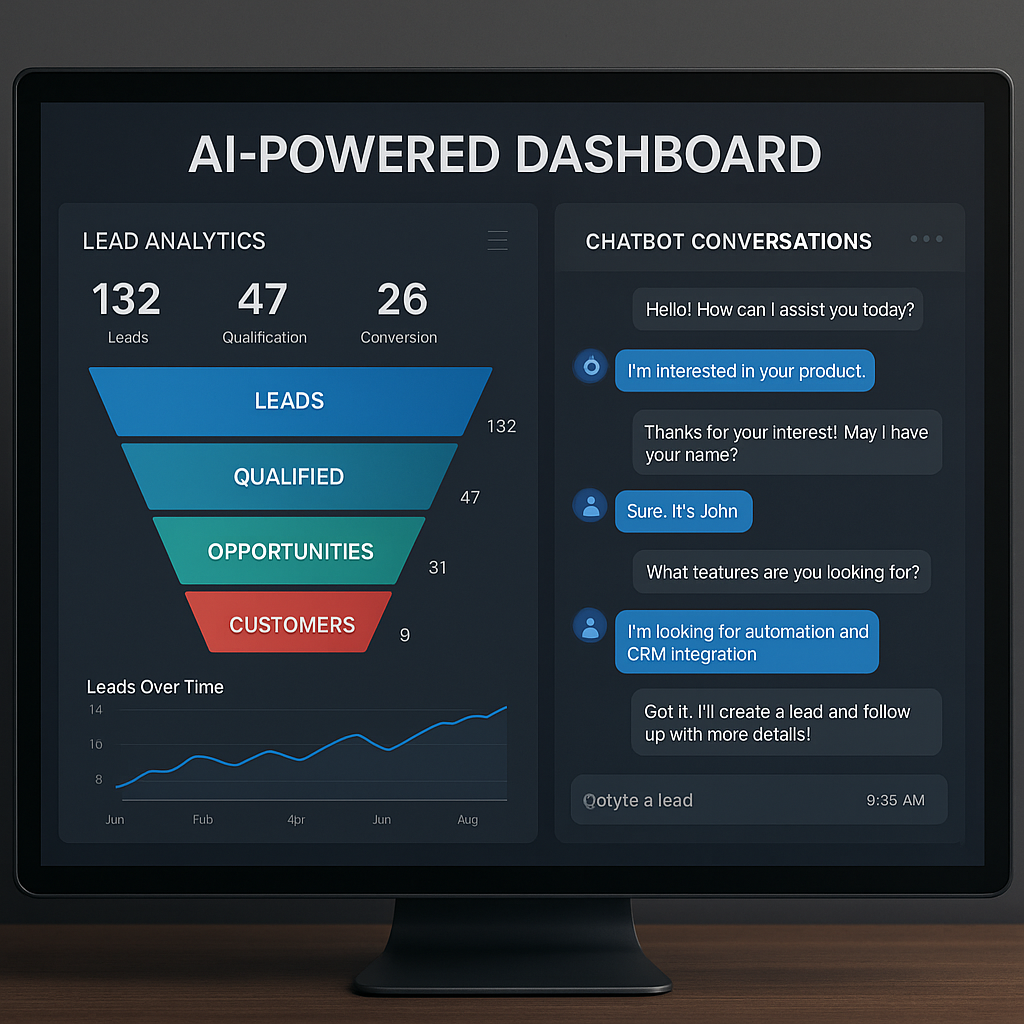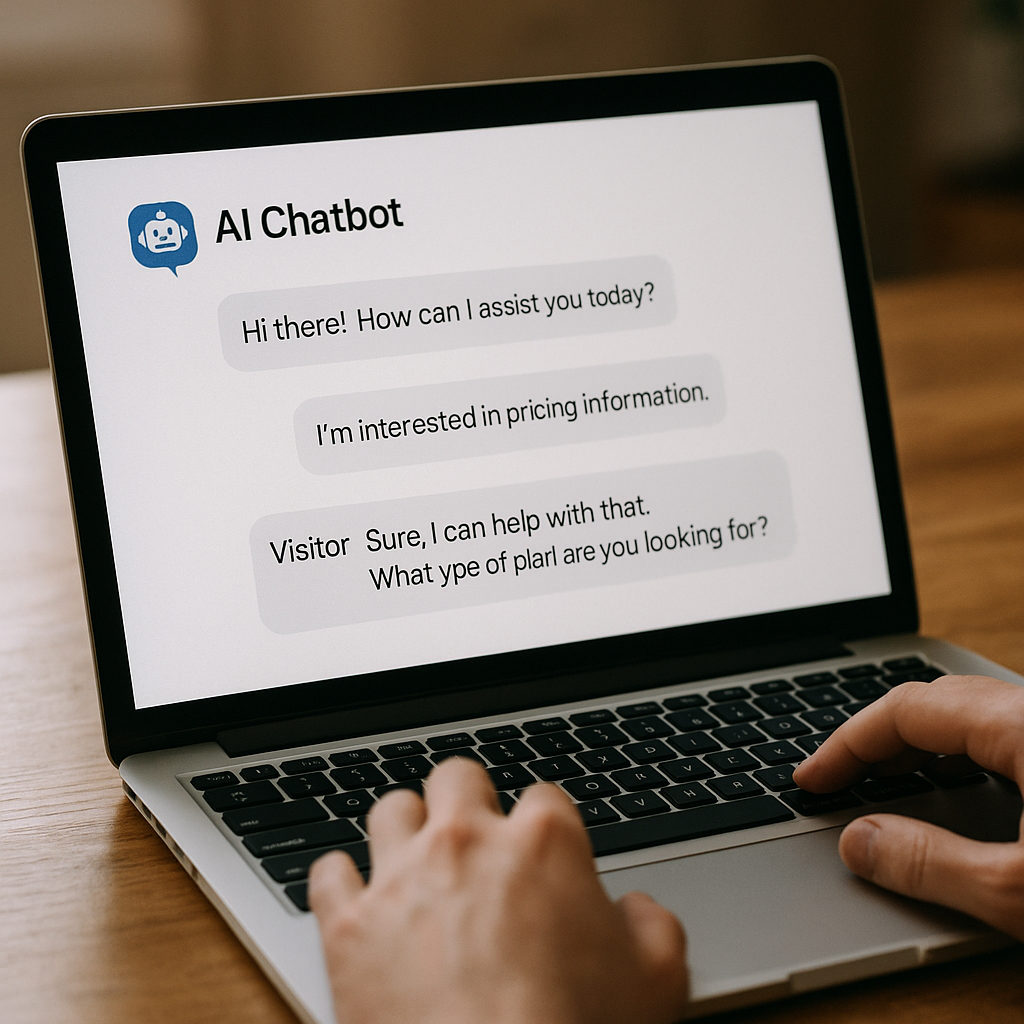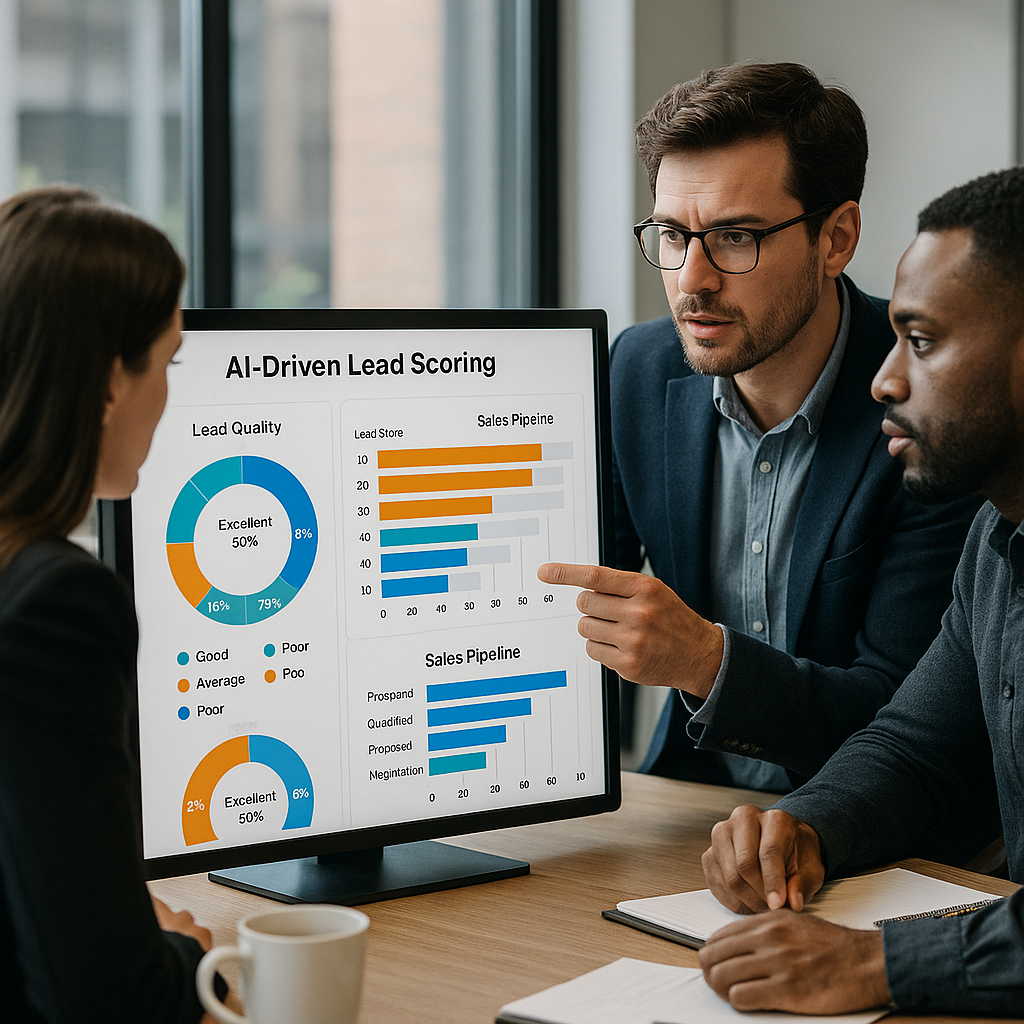Everyone knows AI is rewriting the rules of lead generation and digital marketing.
But what is lead generation with AI, really?
In this ultimate guide, you'll get a comprehensive cheatsheet to mastering AI-powered lead generation for explosive business growth.
Some are plug-and-play tools that work while you sleep.
Some are advanced analytics that predict who will buy—before they even raise their hand.
Some are chatbots that convert casual visitors into qualified leads in minutes.
Some are new, driven by machine learning and natural language processing.
Some will help you dodge the costly mistakes that most companies make in 2025.
Let's dive right in.

What Is Lead Generation with AI?
Lead generation with AI is the use of artificial intelligence—think machine learning, predictive analytics, and smart automation—to find, qualify, and nurture potential customers at scale. Instead of relying on manual prospecting or static lead forms, AI-powered systems analyze massive datasets, score leads based on real-time behavior, and personalize outreach to the right people at the right moment.
In other words: AI transforms your lead generation from a guessing game into a science.
Why is this so important now? Because the digital marketplace is more crowded than ever. Competition for attention is fierce. Buyers expect personalization and instant answers. And every minute wasted chasing the wrong lead costs you revenue. AI gives you the edge—speed, accuracy, and scalability that humans simply can’t match.
The Unbeatable Benefits of AI-Powered Lead Generation
- Unmatched Speed: AI tools process thousands of data points in seconds, surfacing hot leads before your competitors have even opened their CRM.
- Laser-Sharp Targeting: Machine learning models identify high-intent prospects based on patterns in their behavior—no more wasted outreach.
- 24/7 Engagement: AI chatbots qualify leads and answer questions around the clock, capturing prospects who would otherwise slip through the cracks. Source
- Personalized Outreach: Natural language generation allows you to send emails, messages, and offers tailored to each lead’s interests and stage in the funnel.
- Cost Efficiency: Automate repetitive tasks, reduce manual errors, and lower your cost per lead—sometimes by over 200% compared to traditional methods. Source

How AI Works for Lead Generation (And Why It’s a Game-Changer)
Let’s break down how AI supercharges every stage of the lead generation process:
1. Smart Data Collection and Enrichment
AI systems pull in structured data (like CRM records and contact lists) and unstructured data (think: social media activity, website clicks, support tickets). They automatically cleanse, de-duplicate, and enhance this data—so you’re always working with a fresh, accurate lead pool.
2. Predictive Lead Scoring
Forget static scoring rules. Machine learning models analyze past lead behaviors—such as email opens, site visits, and content downloads—to predict which leads are most likely to convert. The result? Sales teams can focus on leads with the highest buying intent and close more deals, faster. Source
3. AI Chatbots and Conversational Agents
Modern AI chatbots engage website visitors instantly, asking qualifying questions, capturing contact details, and even booking meetings. They create a frictionless experience that turns passive browsers into active, qualified leads—sometimes boosting conversion rates from a measly 3% to over 40%. Source
4. Automated Multi-Channel Nurturing
AI integrates with email, SMS, chat, and even voice. It sends personalized messages at the perfect time, nudges leads through your funnel, and adapts its approach as it learns what works best for each prospect.
5. Real-Time Analytics and Optimization
AI-powered dashboards provide live insights into lead quality, campaign performance, and ROI. You can A/B test, tweak, and scale winning strategies without guesswork.
Step-by-Step Guide: Implementing Lead Generation with AI
Ready to put AI to work in your lead gen engine? Follow these proven steps:
Step 1: Define Your Goals and KPIs
Start with clarity. Are you aiming to boost marketing qualified leads (MQLs), shorten your sales cycle, or increase demo bookings? Set specific KPIs—like average lead score, conversion rate, or cost per acquired lead. These metrics will guide your AI implementation and help you measure real progress.
Step 2: Build and Prepare Your Data Foundation
AI thrives on clean, rich data. Aggregate your customer and lead data from all sources—CRM, website, social, email. Use AI-powered tools to scrub duplicates, fix errors, and fill in missing info. Tag leads by persona, industry, or behavior to enable smarter segmentation. Remember: garbage in, garbage out.
Step 3: Choose the Right AI Tools and Platforms
There’s no shortage of options. Some top-rated tools for 2025 include:
- Go High Level: All-in-one CRM with built-in AI appointment booking and nurture flows.
- Instantly.ai: AI-powered cold email platform with inbox health monitoring and unlimited warming.
- Apollo.io: Robust B2B database and multi-channel outreach suite with AI-enhanced lead enrichment.
- Landbot: No-code and AI-driven chatbot builder for web and WhatsApp. Source
- Meet Alfred & Linked Helper 2: Advanced LinkedIn automation for targeted B2B outreach.
- Microsoft Dynamics 365 Sales: Enterprise-grade predictive lead scoring and sales insights. Source
Pick tools that integrate seamlessly with your existing tech stack, offer real-time analytics, and support multi-channel campaigns.
Step 4: Train and Deploy Your AI Models
Feed your model a representative sample of past leads—both won and lost. Machine learning algorithms (like logistic regression, random forest, or neural networks) will learn to spot patterns that signal conversion likelihood. Evaluate your models using metrics like accuracy, AUC-ROC, precision, and recall. Iterate until performance is strong, then deploy!
Step 5: Integrate with Your CRM and Marketing Stack
Connect your AI scoring system to your CRM via API or native integrations. Set up triggers to route hot leads to sales instantly. Sync with your email and chat tools to personalize nurturing sequences based on real-time AI insights.
Step 6: Launch, Monitor, and Optimize
Start with a pilot campaign. Track open rates, click-throughs, conversion rates, and ROI. A/B test subject lines, chatbot flows, and scoring thresholds. Use your AI dashboard to spot trends and bottlenecks, then fine-tune for max conversion.

Practical Examples: AI Lead Generation in Action
B2B SaaS: Predictive Lead Scoring Success
A mid-size SaaS company used predictive lead scoring to analyze demo requests. By integrating AI scores directly into their CRM, they increased sales-qualified leads by 35% and reduced sales response times by 40%. Automated email follow-ups triggered by high scores drove a 25% lift in demo-to-contract conversions.
E-commerce: Chatbot-Driven Conversions
An online retailer implemented an AI chatbot to interact with shoppers, answer product questions, and collect emails for personalized offers. The result? A 20% increase in lead capture and a 15% bump in average order value among chatbot-engaged visitors. Source
Professional Services: Automated Client Nurture
A consulting firm used Facebook Ads to drive traffic to a chatbot that qualified prospects and scheduled discovery calls. The chatbot provided tailored information, follow-up reminders, and even sent incentives. Within a month, they closed $5,500/month in new recurring revenue and built a pipeline of 76 targeted leads in just one week. Source
AI Lead Generation: Best Practices & Common Pitfalls
1. Prioritize Data Quality
High-quality, representative data is non-negotiable. Audit your datasets regularly to eliminate bias and fill in gaps. Overrepresentation of certain segments can skew predictions and lead to missed opportunities or discrimination. Source
2. Respect Privacy and Ethics
Transparency matters. Always comply with data privacy laws like GDPR and CCPA. Get explicit consent for tracking, explain your use of AI, and avoid intrusive profiling. Ethical AI builds trust and long-term value. Source
3. Test, Learn, and Adapt
The best AI lead gen systems are never "set it and forget it." Continuously monitor model performance, retrain algorithms as new data comes in, and fine-tune your messaging and workflows. What works today may not work tomorrow—adapt or get left behind.
4. Scale Thoughtfully
Start small, prove ROI, then scale up. Automate your data flows, document your processes, and build cross-functional teams to manage AI-powered campaigns. Invest in cloud infrastructure as your lead volume grows.
Blueprint: Building an AI Chatbot for Lead Generation
Want to set up a high-converting AI chatbot? Here’s a step-by-step playbook inspired by Landbot’s proven approach (full tutorial):
- Define Your Goal: Is it to book calls, collect emails, or qualify prospects? Be specific.
- Customize the Welcome Message: Greet visitors with a message that matches your brand’s tone—add images, GIFs, or buttons for interactivity.
- Ask for Key Details: Start with the lead’s name, then ask for their email and phone number using preset blocks. Use buttons for quick, friendly responses.
- Qualify and Segment: Ask about needs or pain points. Use logic blocks to instantly identify high-value leads and route them to sales.
- Export Lead Data: Integrate with Google Sheets, your CRM, or use webhooks for advanced workflows.
- Test and Refine: Share the chatbot with your team, collect feedback, and optimize before going live.
Pro tip: AI chatbots can ask more questions without annoying users, so you get richer data and higher conversion rates compared to static forms.
The Future of Lead Generation with AI: What’s Next?
1. Generative AI for Hyper-Personalization
AI now crafts unique, on-brand content at scale—think custom email subject lines, landing pages, and even video scripts, all tailored to each lead’s profile. This means your outreach isn’t just faster—it’s more relevant and more likely to convert.
2. Conversational AI Gets Smarter
We’re moving beyond basic bots. Context-aware virtual assistants can handle complex buyer questions, understand intent, and hand off to human reps seamlessly. The result: smoother customer journeys and higher satisfaction.
3. Unified Data Ecosystems
Expect even deeper integration across marketing, sales, and support. AI will connect the dots between every touchpoint, enabling frictionless buyer experiences from first click to closed deal.
4. Predictive Nurturing and Real-Time Adaptation
In 2025, AI will not just score leads, but actively adapt nurturing sequences in real time. As prospects engage with your brand, AI will adjust messaging, timing, and offers automatically for maximum impact.

AI Lead Generation Cheatsheet: Key Takeaways
- Lead generation with AI delivers speed, accuracy, and personalization that traditional methods can’t touch.
- Start with clean, comprehensive data—and never stop improving your models.
- Use AI for predictive lead scoring, chatbots, and automated nurturing to convert more prospects, faster.
- Always prioritize privacy, ethics, and compliance.
- Test, learn, and scale smart—AI is a journey, not a one-time fix.
Your Next Steps: Launch Your AI-Powered Lead Generation Engine
Feeling inspired? Here’s how to get started with lead generation with AI today:
- Audit your existing data and lead gen processes—identify gaps and opportunities for automation.
- Define clear goals and KPIs for your AI project.
- Pilot a proven AI tool (like Go High Level, Instantly.ai, or Landbot) on a small segment of your funnel.
- Iterate, measure, and optimize. Let the data—and your AI—guide your next moves.
- Stay curious! The AI landscape is evolving fast. Keep learning, testing, and adapting to stay ahead of the pack.
Lead generation with AI isn’t just the future. It’s the present—and the companies who master it today will dominate tomorrow’s market.
Sources: Landbot Chatbot Tutorial | Microsoft Predictive Lead Scoring | Forbes: AI and Lead Gen Ethics